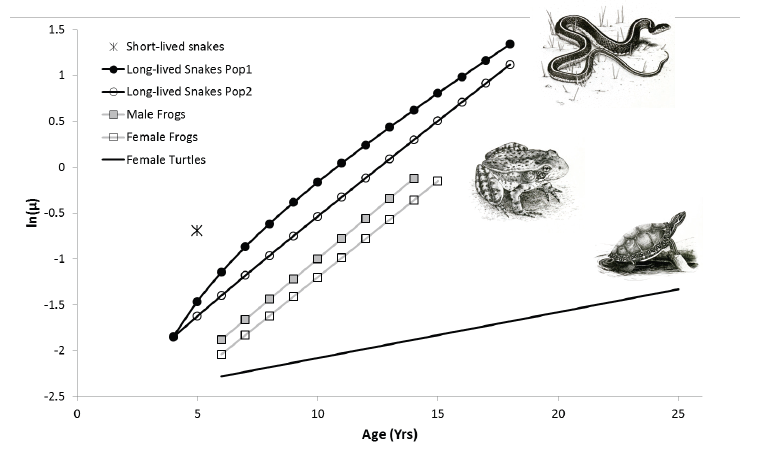Applied Population Ecology Lab
OUR RESEACH
We work in a range of systems and taxa that are subject to a diverse of set of environmental drivers. What unites our work are the themes we use to address questions.
1 - our approaches draw heavily from ecological theory and works to test theory using applied systems.
2 - we emphasize a strong quantitative approach, including integration of large data sets and the development of robust statistical and modeling tools for ecological analyses.
3 - we place an emphasis on application and linking research and models to decision-making.
Below are examples of the research projects that our lab is currently working on. |
Climate change and terrestrial salamanders
We are working with a network of collaborators in the northeast on a study to understand climate-change impacts on red backed salamanders (SPARCNet - Salamander Population and Adaptation Research Collaborative Network). The project centers around a series of replicate plots where we are monitoring salamander populations using mark-recapture methods.
Life History Evolution of Island Reptiles
|
Our lab contributes as co-PIs to the NSF funded SMAL project, which is led by Amanda Sparkman at Wesmont College and Tonia Schwartz at Auburn University. The work seeks to understand the genetic, physiological, demographic, and ecological mechanisms associated with evolution of body size. Our contributions focus on the demographic and life-history changes that are associated with changes in body size within reptile species on the Channel Islands. Learn more about the SMAL project and the research team leading this effort.
|
How does temperature affect amphibian host-pathogen dynamics?
Understanding the role of temperature in host-pathogen dynamics is important for predicting infectious disease dynamics. Our work on newts and chytrid fungus focuses on how temperature affects in-host dynamics in a seasonal environment. The project is funded by the NSF EEID program and includes collaborators at the University of Vermont, University of Massachusetts, and the USGS Wildlife Health Center in Madison, Wisconsin. |
Thermal ecology of turtles and forest management.
Our lab contributes to research led by Julian Avery at Penn State's Stone Valley forest to understand how turtle behavior and habitat selection relates the the thermal landscapes in which they live. Using a combination of telemetry, thermal sensors, and remote sensing, we are learning how forest management shapes the thermal landscapes at the forest and how turtles navigate these landscapes to meet their needs. Our goal is to determine how forest management practices can be used to mitigate effects of changing climates on forest wildlife species. The project is funded by a USDA McIntire-Stennis grant and graduate students on the project are teaming with our partners at the Shaver's Creek Environmental Center, which is located in the school forest, to assist with their education and outreach mission.
Climate effects population and range dynamics of red-backed salamanders
We are working with a network of collaborators in the northeast on a study to understand climate-change impacts on red backed salamanders (SPARCNet - Salamander Population and Adaptation Research Collaborative Network). The project centers around a series of replicate plots where we are monitoring salamander populations using mark-recapture methods. We will use a combination of natural environmental variation and experimental manipulations to establish climate relationships for each study area and how they vary across the salamanders range. We hope to eventually link this with coarser monitoring of presence and abundance to develop a cross-scale understanding of range-dynamics for this species.
Predicting the effects of environmental change on amphibian communities
|
As part of a larger working group funded through the USGS Powell Center and the USGS Amphibian Research and Monitoring Initiative, we are attempting to better understand among species predictors of climate impacts on amphibian species. The effort relies on hundreds of time-series of amphibian occurrence probabilities and dozens of long-term mark-recapture studies to identify important climatic drivers and understand how their affect varies among species and systems.
Learn more about the Powell Center and our working group at the Powell Center Website. |
Integrating habitat and community interactions into species distribution models
|
Community interactions have long been known to be important in structuring breeding amphibians, which often use small wetland habitats such as vernal pools in the northeast. Mesocosm studies have demonstrated the importance of competition, predation, and hydro-period for these species. Our goal is to translate our understanding from experimental systems into natural systems to better understand the processes structuring communities. We use a dynamic modeling approach for field data to estimate interactions and the importance that predators and annual variability in water availability have in structuring occurrence patterns.
|
Accounting for misidentification when modeling species distributions
|
Misidentification is a problem for many ecological data sets and dealing with this source of observational error is increasingly important as we rely more on publicly collected data sets and large species occurrence databases. We have been working to quantify rates of misidentification and to develop statistical methods that properly deal with these errors when making inferences.
|
Demographic outcomes of aging in wild populations
|
Bio-demographic methods to understand patterns of aging in wild animals provide insights into the processes that affect rates of aging. Although evidence is limited, there is some suggestion that rates of senescence may be lower in taxa such as snakes, turtles, and amphibians. We are working to try to better understand rates of senescence in these species and using a comparative approach to better understand factors that affect aging in these groups.
|
Proudly powered by Weebly





